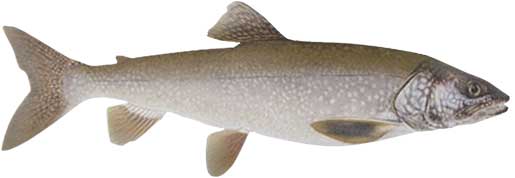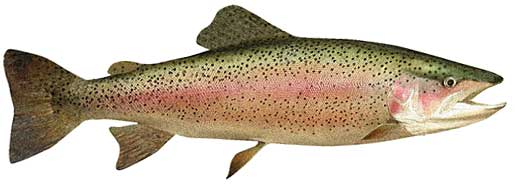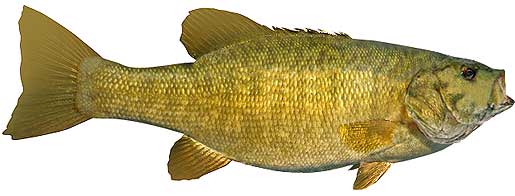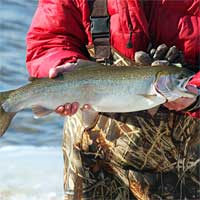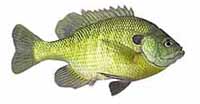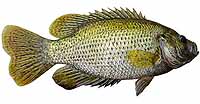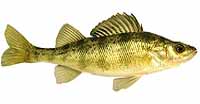Fishing Report For Higgins Lake, IL
By Rick Seaman
January 2, 2025
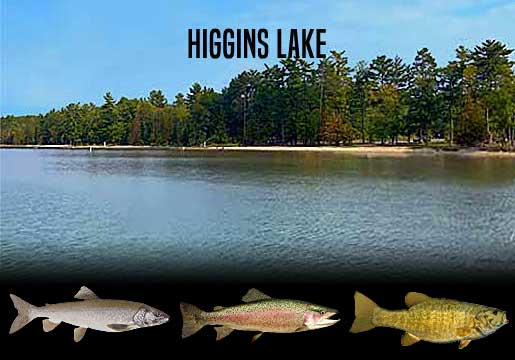
Fishing Reports
Popular Fish Species Higgins Lake, MI
Lake Trout
Current Report: Good
Lake trout thrive in deep, cold water. Higgins Lake has water depths over 120 feet where these lake trout often hold.
FALL. Lake trout are returning to relatively shallow water, as Fall weather cools the lake. They spawn in the Fall, and for a few weeks can typically be found 20 to 60 feet deep on points, flats and humps that have a rocky bottom. Trolling or casting here with flashy spoons and bucktail jigs is popular. Good catches have been reported in the channels around the islands, and in the narrows between the two lake bowls.
WINTER. Favoring water temperatures in the 40's, lake trout find areas to their liking in 70 to 130 feet of water, and tend to stay there throughout the cold months. Learning these areas before the lake ices over can get you into some of the better area for ice fishing. Patient anglers willing to work slowly are catching some nice lake limits through the ice. After ice out, trolling with leaded line or downriggers, or vertical jigging with spoons and jigs, completes the cold-water season in 100 feet of water, or deeper.
SPRING. Spring weather finds lake trout, along with baitfish, into 35 to 60 feet of water. Lakers are being caught in areas of the lake which have deep water next to these shallower feeding area. Jigs and heavy spoons are catching the majority of these big feeders. Slow trolling with leaded line or downriggers allows small crankbaits and spinners to be worked in deeper water, which also produces some nice lakers. Lake trout feed on small fish, so lures imitating baitfish, sunfish, perch or small trout are good choices. Flashy spoons can be fished at any depth, either jigging, trolling or cast and retrieve. For big lakers, use larger baits.
SUMMER. Summer heat drives lake trout deeper, around 60 to 100 feet deep. Lake trout prefer to stay deep, near the thermocline throughout Summer. They look for depth variations like ditches, channels, humps and ledges, but are being caught in the deeper water around this structure. Heavy jigs and spoons, as well as low trolling with leaded line or downriggers produce many of the lakers being caught during Summer.
Rainbow Trout
Current Report: Fair To Good
FALL. Cooling water temperatures in the shallows, draw rainbow trout out of deeper Summer depths. Locals report catching rainbow trout in weedy areas around the islands and Detroit Point. Casting and trolling are both catching fish. Panther Martin, and other similar spinners, work well for both methods. Anglers are now catching them 20 to 60 feet deep on rocky banks, wind-blown points, rocky structure, humps, and anywhere baitfish are gathering. Now that they had a full summer to grow, there are some nice size rainbow to be caught. Small spinners, spoons, jigs, miniature crankbaits and swimbaits are good choices, as are salmon eggs and prepared baits. Fly fishing is not covered in this website, but rainbow trout are being caught on plenty of other lures and bait.
WINTER. When Winter sets in, and the lake freezes over, jigging spoons, and jigs tipped with bait, catch rainbows out of 60 feet of water, and deeper. After ice out, deep trolling with leaded line or downriggers, or vertical jigging with spoons and jigs, are the best approach during the cold-water season.
SPRING. As water begins to warm in early Spring, rainbow trout move from their late winter holding areas to shallow, warmer water 20 to 40 feet deep. A good number of rainbows are typically caught from mid morning to late afternoon, during the warmest water of the day. Flats and rocky structure are quick to warm in the afternoon sun. A wide variety of small spinners, spoons and bait are catching most of the fish.
SUMMER. Once Summer is here to stay, the warmer water drives rainbow deeper, 50 to 80 feet deep, occasionally deeper. Trolling with spoons, spinners and crankbaits, using downriggers or leaded line, and drift fishing with bait, are currently the most productive methods. Following drop-offs into deeper water, along structure or creek channels, is a major key to getting bites. Anglers fishing from the bank are using nightcrawlers or Berkley PowerBait, with heavy weights on a Carolina rig, to get baits in deeper water.
Smallmouth Bass
Current Report: Good
Higgins Lake is a decent smallmouth fishery. The Michigan B.A.S.S. Nation 2024 State Championship was won with a 10-fish limit weighing over 35 pounds.
FALL. As Fall arrives, smallmouth here follow schools of baitfish into coves and bays 8 to 20 feet deep. Anywhere you find rocks or rip-rap is a good place to fish here. Crawfish are a primary food source for smallies and they live amongst the rocks. Fishing next to drop-offs can also enhance your chances. Mid-range crankbaits are a good way to cover lots of water, and the smallmouth here are prone to strike them aggressively. Fishing shallow for smallmouth is often good on cold, windy, cloudy and rainy days.
WINTER. Winter will isolate them around deeper structure, points and creek channels, often suspending in open water above these features. They can generally be found from 20 to 35 feet deep, both while ice fishing and open water after ice out. Here they hold, feeding less frequently, awaiting warmer water to return in Spring.
SPRING. When water temperatures rise into the 50's now, smallmouth have moved from deep wintering spots to shallower water, just outside spawning areas. They feeding heavily in 5 to 15 feet of water at this time, and are typically caught on jerkbaits, crankbaits, tube baits, Ned rigs, and crayfish imitating plastics. Once water warms into the high 50's, they move into shallower water, and create nests in gravel or sand areas, then lay their eggs. Females then move to deeper water and males remain to guard the eggs, and then the fry. After a couple weeks, the males also move to 15 to 25 feet deep, and feed aggressively. Crankbaits, tube baits, Ned rigs, plastic worms, spoons and swimbaits are catching smallies during this period.
SUMMER. Smallmouth bass, including a few trophy-size gems, are currently feeding shallow early and late in the day, where they are being caught on topwater, crankbaits, swimbaits, Ned rigs and tube baits. Smallmouth bass here feed on crawfish and small sunfish. They prefer rocky or gravel bottom areas, as this is where crayfish live. During the hotter parts of the day, they are being caught on points, humps, and ledges 15 to 25 feet deep. Often these deeper fish are part of a large school of smallmouth.
Fishing Video
Fish species to fish for...
Guide to fishing for largemouth bass, smallmouth bass, channel catfish, walleye, rainbow trout, brook trout, brown trout, lake trout, bluegill, rock bass and yellow perch at Higgins Lake in Michigan.
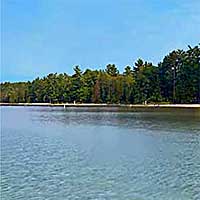 Higgins Lake is a 10,000-acre lake in the northeast part of the lower peninsula. Improved roads circle the lake giving anglers access to some of the 21 miles of shoreline for fishing from the bank. Ice fishing for perch and lake trout is very popular in winter.
Higgins Lake is a 10,000-acre lake in the northeast part of the lower peninsula. Improved roads circle the lake giving anglers access to some of the 21 miles of shoreline for fishing from the bank. Ice fishing for perch and lake trout is very popular in winter.
Primary fish species to catch
Click images for fishing tips and details about each species.
Today's Weather & Forecast
Fishing Boat Rentals
Click here for fishing boat rentals at this lake.
Marinas
Click here for marinas.
Public Boat Launch Ramps & Landings
Click here for boat ramps.
Click here for a Michigan Fishing License.
Higgins Lake, MI Map - Fishing & Access
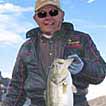 Rick Seaman is a fishing enthusiast with over five decades of fishing experience, a retired tournament fisherman, author of numerous published articles on fishing, and co-author of the book "Bass Fishing - It's not WHAT you throw, It's WHERE you throw it".
Rick Seaman is a fishing enthusiast with over five decades of fishing experience, a retired tournament fisherman, author of numerous published articles on fishing, and co-author of the book "Bass Fishing - It's not WHAT you throw, It's WHERE you throw it".
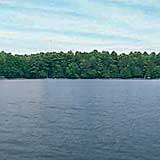 Contact Information
Contact Information
B & B Sports Center & Marina
431 Clare Blvd
Roscommon, MI 48653
989 821-6549
Fishing lakes in each state
100625
Higgins Lake, Michigan Reports
MICHIGAN


Fishing for bass, walleye, trout and perch in the northeast part of the lower peninsula, MI.


